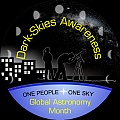For GAM 2012 use the menu on the right side below
|
May 3 By Bob Gent |
Back to the GAM DSA Blog |  |
| 2012's Global Astronomy Month has ended, but the Dark Skies Awareness Blog will continue. Guest Blogger Bob Gent shares his story of fighting light pollution. |
||
Challenges of Night Sky Protection
by Bob Gent
Until the 20th Century, light pollution was rarely a problem. I remember as a child in the early 1950s, the Phoenix, Arizona skies were crystal blue in the day, and stars were brilliant at night. Wow! How times have changed. In the 1970s, I became keenly aware of the problem of ever brighter sky glow, and the loss of the night skies. I had to drive farther out of the city to appreciate the formerly magnificent night skies of the Phoenix suburbs.
It took me a many years to learn that I could stop running and tackle light pollution head on. It started back in 1994, a few years after the International Dark-Sky Association (IDA) was formed. A friend suggested that our local astronomy club in San Antonio set up a booth at Earth Day. She wanted to highlight the endangered constellations, and she had her high school class make posters of the threatened “species.” My first reaction was, “You’ve got to be joking!” But she was persistent, and I decided to help. To get us started, I wrote to Dr. Dave Crawford, co-founder and Executive Director of IDA. He sent us hundreds of information sheets to give us some background, and with that we made flyers and participated in Earth Day.
The following year in 1995, we hosted an Astronomical League Annual Convention (ALCon 1995), and we made “Dark Skies” our primary theme. Dr Tim Hunter, the other IDA co-founder, was our lead speaker. Tim spent a lot of time with us, and invited me to join IDA. I thought to myself, “That’s all I need -- another organization to join.”
In 1996, my wife, Terrie, was transferred to Tucson, and I stayed in touch with Tim. Shortly after arriving in Southern Arizona, Tim invited me to a meeting with him, Dave & Mary Crawford, and IDA President Don Davis of the Planetary Science Institute. Dave said he needed some help at IDA, and I thought silently, “I’ll bet you do!” At that time, IDA had no office, no full time employees, and Dave served as the “volunteer” Executive Director. A few days later, I had another lunch with Dave and Mary. I said, “OK, I’ll work part time at IDA. How much can you pay?” Dave handed me the IDA financial report. I quickly noticed that they had no money to pay me, so I said, “I’ll volunteer.”
From that point on, I worked the next twelve years as a full time IDA volunteer. I learned about the problems of glare, light trespass, melatonin suppression, the impact on wildlife and so much more. Also, IDA has solutions to these problems, and it’s not complicated and expensive like storing nuclear waste. It’s simple: shield the lights and turn them off when you don’t need them. We’d save money and see better while protecting the night sky. Why didn’t we think of this years ago!
Later, Terrie was transferred to Washington DC, and I became IDA’s DC liaison officer. I spoke at state, county, and city legislative sessions across the region whenever lighting controls were being added to codes or being debated. A few years after that Terrie was transferred to Italy to run the law office at Aviano Air Base, and I became the IDA European Liaison Officer. I traveled to dozens of countries to help with international meetings on preservation of the night sky.
As the years passed, awareness grew. Hundreds, if not thousands, of communities around the world passed outdoor lighting codes. We made the front cover of National Geographic as well as many other magazines and newspapers. We were on NPR’s Science Friday and regional TV news programs. We kept pushing, and if we felt any give, we would push harder. Now we have “Globe at Night, and there are so may other programs around our planet, this pale blue dot. Slowly we are making progress, but it is never enough.
In 2005, Terrie retired and after 24 moves in 39 years, we were ready to settle down. A few years earlier, we had purchased a residential lot in Cochise County Arizona to build a home. We visited the lot at night, and it was perfect. The area had a good county lighting code, and I could see the Milky Way very brightly from the lot. There were no streetlights and no plans for any. I asked the developer and neighbors about streetlights, and there were none planned and none wanted. This would be just what we needed. Since we had seen all 50 states and forty countries, we decided it was time to live in one location, and Cochise County was the place. Now we also have a backyard astronomical observatory.
If you are interesting in stopping light pollution, your first step is to study the issues in detail. Also, you should build friendships with people who can help you. This means spending time with news reporters and elected officials. Find a good lighting designer who understands the issues, and this will help tremendously. Who makes the key decisions in your area? Who is influential? Would you like to help us preserve the nighttime environment and protect our dark skies? If so, your first step is www.darksky.org.
|
|
About the author: Lt Col Bob Gent is a retired USAF Space Systems Officer, and he is the past president of the Astronomical League, an educational federation of 250+ astronomical societies and 15,000 members. He is also the past president of the board of the International Dark-Sky Association. IDA has thousands of members from over 70 countries. |








